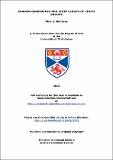Files in this item
Random generation and chief length of finite groups
Item metadata
| dc.contributor.advisor | Quick, M. R. (Martyn R.) | |
| dc.contributor.advisor | Roney-Dougal, Colva Mary | |
| dc.contributor.author | Menezes, Nina E. | |
| dc.coverage.spatial | iv, 204 | en_US |
| dc.date.accessioned | 2013-05-30T15:34:00Z | |
| dc.date.available | 2013-05-30T15:34:00Z | |
| dc.date.issued | 2013 | |
| dc.identifier.uri | https://hdl.handle.net/10023/3578 | |
| dc.description.abstract | Part I of this thesis studies P[subscript(G)](d), the probability of generating a nonabelian simple group G with d randomly chosen elements, and extends this idea to consider the conditional probability P[subscript(G,Soc(G))](d), the probability of generating an almost simple group G by d randomly chosen elements, given that they project onto a generating set of G/Soc(G). In particular we show that for a 2-generated almost simple group, P[subscript(G,Soc(G))](2) 53≥90, with equality if and only if G = A₆ or S₆. Furthermore P[subscript(G,Soc(G))](2) 9≥10 except for 30 almost simple groups G, and we specify this list and provide exact values for P[subscript(G,Soc(G))](2) in these cases. We conclude Part I by showing that for all almost simple groups P[subscript(G,Soc(G))](3)≥139/150. In Part II we consider a related notion. Given a probability ε, we wish to determine d[superscript(ε)] (G), the number of random elements needed to generate a finite group G with failure probabilty at most ε. A generalisation of a result of Lubotzky bounds d[superscript(ε)](G) in terms of l(G), the chief length of G, and d(G), the minimal number of generators needed to generate G. We obtain bounds on the chief length of permutation groups in terms of the degree n, and bounds on the chief length of completely reducible matrix groups in terms of the dimension and field size. Combining these with existing bounds on d(G), we obtain bounds on d[superscript(ε)] (G) for permutation groups and completely reducible matrix groups. | en_US |
| dc.language.iso | en | en_US |
| dc.publisher | University of St Andrews | |
| dc.rights | Creative Commons Attribution-NonCommercial-NoDerivs 3.0 Unported | |
| dc.rights.uri | http://creativecommons.org/licenses/by-nc-nd/3.0/ | |
| dc.subject | Finite group theory | en_US |
| dc.subject | Random generation | en_US |
| dc.subject | Chief length | en_US |
| dc.subject | Probabilistic group theory | en_US |
| dc.subject | Almost simple groups | en_US |
| dc.subject | Permutation groups | en_US |
| dc.subject | Matrix groups | en_US |
| dc.subject | Computational group theory | en_US |
| dc.subject | Group theory | en_US |
| dc.subject.lcc | QA177.M4 | |
| dc.subject.lcsh | Finite groups | en_US |
| dc.subject.lcsh | Combinatorial probabilities | en_US |
| dc.subject.lcsh | Group theory--Generators | en_US |
| dc.title | Random generation and chief length of finite groups | en_US |
| dc.type | Thesis | en_US |
| dc.type.qualificationlevel | Doctoral | en_US |
| dc.type.qualificationname | PhD Doctor of Philosophy | en_US |
| dc.publisher.institution | The University of St Andrews | en_US |
This item appears in the following Collection(s)
Except where otherwise noted within the work, this item's licence for re-use is described as Creative Commons Attribution-NonCommercial-NoDerivs 3.0 Unported
Items in the St Andrews Research Repository are protected by copyright, with all rights reserved, unless otherwise indicated.


